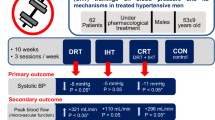Abstract
Eighty-seven medicated essential hypertensives received either thermal biofeedback (TBF) or progressive muscle relaxation (PMR) training as a substitute for their second-stage antihypertensive medication. The psychological changes accompanying the treatments were obtained at pretreatment, at post-treatment and at the 3- and 6-month follow-up. Few psychological changes were noted, owing in part to the absence of psychopathological elevations at pretreatment. Short-term psychological changes were greater in patients who were withdrawn from their second-stage antihypertensive medication and then treated compared with those treated and then withdrawn from their medication. This finding may reflect the presence of antihypertensive medication side effects involving psychological factors. In general, TBF patients were more Type B at long-term follow-up compared with PMR patients, who tended toward greater Type A characteristics.
Similar content being viewed by others
References
Bali, L. R. (1979). Long-term effect of relaxation on blood pressure and anxiety levels of essential hypertensive males: A controlled study.Psychosomatic Medicine, 41(8), 637–646.
Beck, A. T., Ward, C. H., Mendelson, M., Mock, J., & Erbaugh, J. (1961). An inventory for measuring depression.Archives of General Psychiatry, 5 561–571.
Bernstein, D. A., & Borkovec, T. D. (1973).Progressive relaxation training. Champaign, Illinois: Research Press.
Blanchard, E. B., Andrasik, F., Appelbaum, K. A., Evans, D. D., Myers, P., & Barron, K. D. (1986). Three studies of the psychological changes in chronic headache patients associated with biofeedback and relaxation therapies.Psychosomatic Medicine, 48 73–83.
Blanchard, E. B., McCoy, G. C., Andrasik, F., Acerra, M. Pallmeyer, T. P., Gerardi, R., Halpern, M., & Musso, A. (1984). Preliminary results from a controlled evaluation of thermal biofeedback as a treatment for essential hypertension.Biofeedback and Self-Regulation, 9 471–495.
Blanchard, E. B., McCoy, G. C., Musso, A., Gerardi, M. A., Pallmeyer, T. P., Gerardi, R. J., Cotch, P. A., Siracusa, K., & Andrasik, F. (1986). A controlled comparison of thermal biofeedback and relaxation training in the treatment of essential hypertension: I. Short-term and long-term outcome.Behavior Therapy, 17 563–579.
Blanchard, E. B., Radnitz, C., Schwarz, S. P., Neff, D. F., & Gerardi, M. A. (1987). Psychological changes associated with self-regulatory treatment of irritable bowel syndrome.Biofeedback and Self-Regulation, 12 31–38.
Buss, A. H., & Durkee, A. (1957). An inventory for assessing different kinds of hostility.Journal of Consulting Psychology, 21 243–248.
DeRogatis, L. (1975).The SCL-90R. 1228 Wine Spring Lane, Baltimore,, Maryland.
Green, E. E., Green, A. N., & Norris, P. A. (1979). Preliminary observations on the new nondrug method for control of hypertension.Journal of the South Carolina Medical Association, 75 575–586.
Hafner, R. J. (1982). Psychological treatment of essential hypertension: A controlled comparison of medication and meditation plus biofeedback.Biofeedback and Self-Regulation, 7 305–316.
Holmes, T. H., & Rahe, R. H. (1967). The social readjusment rating scale.Journal of Psychosomatic Research, 11 213–218.
Jacobson, E. (1938).Progressive relaxation. Chicago: University of Chicago Press.
Jenkins, C. D., Zyzanski, S. J., & Rosenman, R. H. (1965).Jenkins Activity Survey. New York: Psychological Corp.
McCaffrey, R. J., & Blanchard, E. B., (1985). Stress management approaches to the treatment of essential hypertension.Annals of Behavioral Medicine, 7 5–12.
Rathus, S. A. (1973). A 30-item schedule for assessing assertive behavior.Behavior Therapy, 4 398–406.
Rosen, R. C., & Kostis, J. B. (1985). Biobehavioral sequelae associated with adrenergic-inhibiting antihypertensive agents: A critical review.Health Psychology, 4 579–604.
Seer, P., & Raeburn, J. N. (1980). Meditation training and essential hypertension: A methodological study.Journal of Behavioral Medicine, 3 59–71.
Spielberger, C. D. (1980).Preliminary manual for the State-Trait Anger Scale (STAS). Tampa, Florida: University of South Florida.
Spielberger, C. D., Gorsuch, R. L., & Lushene, R. E. (1970).STAI manual for the State-Trait Anxiety Inventory. Palo Alto: Consulting Psychologists Press.
Taylor, J. A. (1953). A personality scale of manifest anxiety.Journal of Abnormal and Social Psychology, 48 285–290.
Author information
Authors and Affiliations
Additional information
This research was supported by a grant from NHLBI, HL-27622.
Rights and permissions
About this article
Cite this article
Blanchard, E.B., McCaffrey, R.J., Musso, A. et al. A controlled comparison of thermal biofeedback and relaxation training in the treatment of essential hypertension: III. Psychological changes accompanying treatment. Biofeedback and Self-Regulation 12, 227–240 (1987). https://doi.org/10.1007/BF00999203
Received:
Issue Date:
DOI: https://doi.org/10.1007/BF00999203




